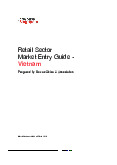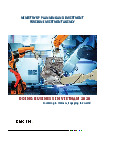















Preview text:
Retail in Vietnam An accelerated shift towards omnichannel retailing July 2020 Foreword 03
Economic resilience in the face of COVID-19 04
Robust and resilient economic fundamentals 05
How COVID-19 is changing the Vietnamese consumer 06 Stay home, stay healthy 07
Broad-based shift towards e-commerce 08 Segment analysis 09 Traditional grocery retailers 09 Convenience stores 10 Hypermarkets and supermarkets 11 e-Commerce 12 Looking ahead 14 Contact us 15
Retail in Vietnam | An accelerated shift towards omnichannel retailing Foreword
As early and decisive COVID-19 containment efforts bear fruit, Vietnam is expected to
remain one of the fastest-growing economies in Southeast Asia. On the back of strong
and resilient economic fundamentals, Vietnamese consumers are also amongst the most
optimistic despite the onset of the global pandemic.
But that is not to say that retail will return to business as usual after the crisis. Within a few
short weeks, COVID-19 has resulted in social distancing across Vietnam, isolating people in
their homes and shutting down parts of the economy. From a retail sector perspective,
products that were once basic needs have now become priority human needs, which
now need to be delivered without the high degree of physical, in-person interaction that we have become accustomed to.
Delivering this entails a mindset shift for many retails players. Before the onset of
COVID-19, the retail sector did not need to think too hard about how to serve basic human
needs: the focus then was primarily on investing in offerings to serve the Vietnamese
consumer across varying levels of sophistication, and clearly articulating value propositions and brand associations.
But as retailers and consumers alike heightened their focus on safety aspects in the
wake of the COVID-19 outbreak, they have moved to minimise physical interactions
and maximise digital interactions. This has resulted in an accelerated shift towards
omnichannel purchasing behaviours, as e-commerce channels are increasingly used as a
substitute for physical shopping activities.
While some of these changes may be temporary, others may be irreversible. What matters
most has moved from convenience to safety, from cost to simple availability, and from
wants to basic needs. Several shifts in the Vietnamese consumer’s purchasing behaviour,
including a greater focus on health and wellness and in-home dining, and a broad-based
shift towards e-commerce, are likely to become permanent changes in the future that lies ahead.
As we move into the post-COVID world, retailers will need to re-examine consumer
preferences and habits, and re-consider their channel strategies to redefine the consumer
experience and thrive in the new normal. Nguyen Vu Duc Consumer Industry Leader Deloitte Vietnam 03
Retail in Vietnam | An accelerated shift towards omnichannel retailing Economic resilience in the face of COVID-19
Despite the outbreak of the COVID-19 pandemic, Vietnam is expected
to remain one of the fastest-growing economies in Southeast Asia. This
is due in large part to its early and decisive containment efforts, as well
as robust and resilient economic fundamentals.
As a result of the deceleration in economic activity and the downside risks posed by the COVID-19 pandemic,
Vietnam’s Gross Domestic Product (GDP) growth is expected to slow sharply from 7% in 2019 to 4.8% in 2020, (see
Figure 1). Earlier in the first quarter of 2020, economic growth decelerated to a 10-year low of 3.8%, down from 6.8%
in the corresponding period in 20191.
Travel restrictions and other containment measures imposed by the authorities to slow the spread of COVID-19 had
led to lower domestic consumption, and a stagnation of growth in the agricultural sector due to lower demand for
exports and severe salinity intrusion in the Mekong Delta. The manufacturing sector is also facing disruptions to its
supply chain, while growth in the services sector – the sector hardest hit by the pandemic – halved to 3.2% in the first
quarter of 2020, down from 6.5% in the corresponding period in 2019.
Looking ahead, however, Vietnam is expected to remain one of the fastest-growing economies not only within
Southeast Asia, but also within the wider Asia Pacific region despite the short-term economic slowdown as a result of
the COVID-19 outbreak2 (see Figure 2).
Figure 1: Vietnam’s GDP growth rates (2010-2020F) 7% 6.8% 7% 7.1% 7% 6.2% 5.9% 6% 5.3% 5.4% 4.8% 2010 2011 2012 2013 2014 2015 2016 2017 2018 2019 2020 Source: Asian Development Bank
1 “Pandemic pulls Vietnam’s Q1 GDP growth to decade low”. Hanoi Times. 27 March 2020.
2 “Vietnam’s economy to remain one of the fastest growing in Asia despite sharp slowdown due to COVID-19”. Asian Development Bank. 3 April 2020. 04
Retail in Vietnam | An accelerated shift towards omnichannel retailing
Figure 2: GDP growth forecasts for selected Asia Pacific economies (2020F) 4.8% 4% 2.5% 2.3% 1.3% 0.5% 0.2% Thailand
Vietnam India Indonesia China South Korea Malaysia Singapore 5% Source: Asian Development Bank
Robust and resilient economic fundamentals
Over the last decade, Vietnam has been able to maintain a consistent economic growth momentum on the back of
robust and resilient economic fundamentals. In particular, its large and growing middle class are important drivers
of private consumption – which is in turn a significant contributor to GDP (see Figure 3). Estimates suggest that there
will be about be 17 million middle class households in Vietnam by 2030, with Vietnam expected to become the third
largest urban market in terms of consumer numbers and fifth largest in terms of total spending in Southeast Asia by 20303.
Although the COVID-19 outbreak has dampened consumer confidence in the short-term – prior to the COVID-19
outbreak, a survey found that more than 70% of Vietnamese consumers were optimistic that the economy would do
better in 2020 than the year before, but after outbreak, this figure dropped to less than 20%4 – Vietnam is expected
to emerge from the crisis in relatively better position than many other regional economies. This is due in large part to
its early and decisive containment efforts that have enabled it to avoid a large wave of infections, and become one of
the first countries in the world to ease social-distancing measures5.
In the medium- and long-term, improvements to Vietnam’s business environment are also expected to continue, with
public spending likely to be raised further to combat the effects of the pandemic. In addition, supply chain disruptions
are expected to ease as manufacturing heartlands in China resume their operations6, and increased access to
overseas markets enabled by Vietnam’s participation in numerous bilateral and multilateral trade agreements will
help support the economy in its rebound7.
Figure 3: Vietnam’s private consumption as a percentage of GDP (2012-2019) 69% 68% 68% 69% 68% 66% 65% 64% 2012 2013 2014 2015 2016 2017 2018 2019 Source: CEIC Data
3 VN to be among world’s most dynamic markets by 2030”. Viet Nam News. 12 June 2019.
4 “Vietnam Consumer Confidence down in the face of COVID-19”. Vietnam Investment Review. 24 February 2020.
5 “Vietnam’s coronavirus recovery is as good as it gets for emerging economies”. The Wall Street Journal. 24 April 2020.
6 “Coronavirus: China’s manufacturing heartland almost back to normal as over 6 million workers return”. South China Morning Post. 4 March 2020.
7 “East Asia and the Pacific in the Time of COVID-19”. The World Bank. April 2020. 05
Retail in Vietnam | An accelerated shift towards omnichannel retailing How COVID-19 is changing the Vietnamese consumer
The COVID-19 pandemic has resulted in a greater focus on health and
wellness and dining at home, as well as a broad-based shift towards
e-commerce. As Vietnamese consumers become accustomed to these
habits, many of them are likely to become permanent changes in the post-COVID world.
With the onset of the COVID-19 pandemic, domestic demand for consumer goods posted its lowest growth rate since
2014 at 9.8% for the first two months of 2020, as compared to 14.4% for the same period last year8. Nevertheless,
Vietnam is expected to build on the momentum of its rapid retail sector expansion, which has seen successive
year-on-year growth for the last decade (see Figure 4). In particular, consumer sentiment remains optimistic despite
COVID-19, with Vietnamese consumers ranked among the most optimistic globally9.
Figure 4: Retail sales of goods and services (2010-2019) 4,940 VND, trillion 4,396 3,942 3,546 3,223 2,916 2,615 2,369 2,074 1,677 2010 2011 2012 2013 2014 2015 2016 2017 2018 2019 Source: Statista
8 “COVID-19: Vietnam’s consumer changes & retail movements”. Kantar. 17 March 2020.
9 “Vietnam among most optimistic countries despite pandemic”. VNExpress. 15 May 2020. 06
Retail in Vietnam | An accelerated shift towards omnichannel retailing Stay home, stay healthy
With the implementation of social distancing measures across Vietnam, dining out has been largely replaced with
takeaways and eating at home. This has resulted in the surge in sales of convenience foods and cooking aids,
including product categories such as frozen food, canned food, instant noodles and cooking oils. As consumers begin
to take a greater interest in cooking at home, there has also been a rise in popularity of online cooking-at-home
fanpages that feature aesthetically pleasing images of homecooked meals. Facebook groups, such as “Yeu bep” and
“Ghet bep, khong nghien nha”, for instance, are garnering thousands of new members every day10.
Even as the pandemic subsides, many of these habits and behaviours are expected to persist. For example, one study
found that Asian consumers are unlikely to go back to their old habits of frequently dining out: 62% of Vietnamese
consumers, in particular, indicated that they would eat at home more often than before the outbreak11. This signals
a move from an “on-the-go lifestyle” to a more “safe in-home consumption” trend, and has implications not only for
restaurants and food & beverage operators, but also how retailers should stock their shelves to accommodate the new changes in product demand.
As the COVID-19 outbreak intensifying consumers’ focus on their health and wellbeing, health and nutrition products,
such as specialty milk powder and yogurt, as well as personal hygiene products and other household cleaning
products, have also witnessed a rapid surge in demand12. Hand wash and bar soap, for example, saw double- and
even triple-digit sales growth13, as 87% of Vietnamese consumers now wash their hands frequently with soap14.
In addition, personal hygiene product categories such
as mouthwash, body wash, and facial tissues have
witnessed a surge in consumption of 78%, 45% and
35% respectively, as Vietnamese consumers take extra
precautions to protect themselves from COVID-19
through increased washing and cleaning1 . 5 As a number
of new consumers begin to purchase these purchases,
and grow accustomed to using them on a greater
number of usage occasions, we are also likely to witness
long-term behavioural changes for these product
categories that could persist even after the pandemic.
10 “Eating at home is new reality among Vietnamese consumers post COVID-19”. Hanoi Times. 15 April 2020.
11 “Coronavirus pandemic likely to permanently change dining habits of Asian consumers, Nielsen study says’. TODAY. 7 April 2020.
12 COVID-19: Vietnam’s consumer changes & retail movements”. Kantar. 17 March 2020
13 “The COVID-19 impact: Vietnam personal care market jumps by double-digits”. Cosmetics Design Asia. 20 April 2020.
14 “How has COVID-19 impacted Vietnamese consumers?”. Nielsen. 20 February 2020.
15 “How has COVID-19 impacted Vietnamese consumers?”. Nielsen. 20 February 2020. 07
Retail in Vietnam | An accelerated shift towards omnichannel retailing
Broad-based shift towards e-commerce
Spending an average of 6 hours and 42 minutes per day on the Internet1 ,
6 Vietnamese consumers – especially young
urban consumers with high familiarity with digital technology and busy, modern lifestyles – are fairly accustomed to
e-commerce. Nevertheless, despite growing e-commerce adoption, Vietnam’s overall retail landscape still remains
predominantly offline. One recent survey found that 98% of retailers cited brick-and-mortar stores and distribution
channels as accounting for the majority of their sales turnover, with only 2% citing e-commerce channels17.
A similar trend can also be observed in a comparison of store-based and non-store-based sales data, where store-
based sales continue to account for about 97% of retail sales, and non-store-based sales (including e-commerce)
contribute only about 3% (see Figure 5). Prior to the onset of COVID-19 in 2019, product categories such as
electronics and media products, as well as fashion products, accounted for the top two most significant sources
of total e-commerce revenues in Vietnam at 27% and 24% respectively, while food and personal care products accounted for only 16%18.
The COVID-19 outbreak, however, has catalysed a radical, broad-based shift towards e-commerce channels – both
across a wider range of consumer demographics beyond the young urban consumer base, and across a wider
range of product categories. As a result of the pandemic, for instance, more than 50% of Vietnamese consumers
have reduced their frequency of visits to supermarkets, grocery stores, and wet markets, while 25% of them have
increased their online shopping19.
Figure 5: Breakdown of retail sales into store-based and non-store-based sales 1% 2% 2% 2% 1% 1% 99% 98% 98% 98% 97% 97% 2014 2015 2016 2017 2018 2019 Store-based sales Non-store-based sales
Source: Euromonitor, Deloitte analysis
16 “Vietnam’s e-commerce sector is booming, but why do consumers prefer Amazon and eBay?”. South China Morning Post. 30 January 2020.
17 “Traditional trade channels still a main draw in Vietnam”. VietNamNet. 19 October 2020.
18 “eCommerce: Vietnam”. Statista. Retrieved on 26 May 2020.
19 “How has COVID-19 impacted Vietnamese consumers?”. Nielsen. 20 February 2020. 08
Retail in Vietnam | An accelerated shift towards omnichannel retailing Segment analysis
Higher levels of omnichannel purchasing behaviours have been observed as a result of the COVID-19 outbreak, as
consumers look to stock up on groceries and daily necessities. Retailers should capitalise on this momentum to drive
expansion and increase penetration rates as we move into the post-COVID world.
The COVID-19 pandemic had resulted in an abnormal spike in the Vietnamese consumers’ expenditure on FMCG
products in the first quarter of 2020, as the sector hit double-digit growth for the first time in seven years20. This was
due in part to stocking up behaviour, as consumers rushed to purchase staple products, such as fresh food and
essential packaged consumer goods, in response to social distancing measures21.
However, preferences for different retail channels differ by region. In urban areas, where there is greater availability
of larger retail formats, shopping cart sizes were larger as consumers sought to limit travel and contact. In rural
areas, however, where traditional trade channels remain dominant, consumers made more trips. Overall, all channels
witnessed rapid growth – an indication that the pandemic has inadvertently encouraged omnichannel shopping behaviours22.
Traditional grocery retailers
Despite the rapid expansion of modern trade outlets across Vietnam, traditional grocery retailers still have an
important role to play in the overall retail market, and continue to exhibit steady growth. In 2019, traditional grocery
sales grew by 4% to reach a total value of VND 1,027 trillion (see Figure 6).
For many rural consumers and lower-income urban consumer segments who need to budget daily for food and
make purchases in small quantities, traditional grocery retailers, such as local markets and mom-and-pop stores, are
a convenient and affordable alternative to modern trade outlets, such as supermarkets, which are typically perceived to be more expensive.
One recent observation is that a number of traditional grocery retailers have also begun to make improvements to
their store infrastructure, and increase their product assortment to include a higher quality of products, to appeal to
consumers who desire an experience of modern retail.
20 Abnormal FMCG spend in Vietnam pre-lockdown”. Kantar. 18 May 2020.
21 Abnormal FMCG spend in Vietnam pre-lockdown”. Kantar. 18 May 2020.
22 Abnormal FMCG spend in Vietnam pre-lockdown”. Kantar. 18 May 2020. 09
Retail in Vietnam | An accelerated shift towards omnichannel retailing
Figure 6: Number of outlets, floor space, and sales growth for traditional grocery retailers (2014-2019) 641,542 647,556 652,988 658,005 662,592 666,736 12% 5% 5% 5% 4% 4% 21,0112 1,186 21,348 21,492 21,617 21,723 2014 2015 2016 2017 2018 2019 Number of outlets
Floor space (thousand square metres) Sales growth
Source: Euromonitor, Deloitte analysis Convenience stores
Convenience stores have rapidly proliferated across Vietnam in recent years, reaching a market size of VND 4.4
trillion on the back of a healthy sales growth rate of 18% in 2019 (see Figure 7)23. Key players include Family Mart,
Circle K, and B’s Mart, with market shares of 21.4%, 20.7%, and 9.6% respectively24.
For both convenience stores and traditional trade retailers, such as mom-and-pop stores and other traditional
markets, having a location in an area with high footfall is key. However, convenience stores differentiate themselves
from traditional trade retailers with a more “trendy” perception, offering modern facilities, an assortment of ready-to-
eat meals, and digital payment methods, such as e-wallets, that appeal to young urban consumers.
COVID-19 brings new customers to convenience stores
The COVID-19 pandemic has encouraged a significant number of consumers who typically do not purchase
products online or in convenience stores to begin making their first transactions25. As a consequence,
both online and convenience store purchases reached a peak in terms of shopper base during March 2020.
For convenience store players, this represents an opportunity to capitalise on the growing momentum to drive
expansion by increasing penetration rates amongst new consumers, and investing to retain their loyalty even after the pandemic.
Figure 7: Number of outlets, floor space, and sales growth for convenience stores (2014-2019) 34% 1,289 33% 1,188 29% 1,099 947 23% 708 19% 565 18% 40 54 68 80 88 97 2014 2015 2016 2017 2018 2019 Number of outlets
Floor space (thousand square metres) Sales growth
Source: Euromonitor, Deloitte analysis
23 Convenience stores in Vietnam”. Euromonitor. March 2020
24 “Convenience stores in Vietnam”. Euromonitor. March 2020
25 “Abnormal FMCG spend in Vietnam pre-lockdown”. Kantar. 18 May 2020. 10



